Non Sparking Shackles
Shackles are specifically designed for use in hazardous, potentially explosive environments. These components are essential for connecting wire ropes or chains in lifting and rigging operations, offering the critical feature of easy unloading.
Non Sparking Shackles
Shackles are specifically designed for use in hazardous, potentially explosive environments. These components are essential for connecting wire ropes or chains in lifting and rigging operations, offering the critical feature of easy unloading. The product numbering system, beginning with Q/ZBF-292, indicates different sizes identified by a load limit (T), likely the Working Load Limit (WLL) in tonnes, ranging from 1T up to 10T, alongside detailed dimensions ($K$ and $H$ in mm). .
Non-Sparking Safety Feature
The primary safety characteristic is their classification as Non-sparking Tools. Unlike standard steel tools, these shackles are manufactured from specialized, softer alloys—Beryllium Copper (Be-Cu) and Aluminum Bronze (Al-Br). When accidentally struck against metal, concrete, or other hard surfaces, these materials will not produce a hot spark capable of igniting flammable gases, vapors, or dusts present in the surrounding atmosphere. This makes them indispensable for industries such as petrochemicals, oil and gas, mining, and grain processing.
Material Composition and Comparison
The two available materials, Beryllium Copper and Aluminum Bronze, offer users a choice based on their specific needs. Beryllium Copper generally provides superior tensile strength and hardness, while Aluminum Bronze is often preferred for its excellent corrosion resistance and lower material cost. The specification table illustrates a slight difference in density, as the Be-Cu shackles consistently weigh more (e.g., 4500g for the 10T size) than the corresponding Al-Br shackles (4000g for the 10T size), reflecting the differences in alloy composition.
Manufacturing Method and Quality
These shackles are produced via Precision Casting. This manufacturing technique ensures high dimensional accuracy and consistent mechanical properties throughout the product. Precision casting is crucial for load-bearing equipment like shackles, as it minimizes internal defects and ensures the material structure is uniform, directly contributing to the product’s Working Load Limit (WLL) and overall safety factor. The use of this high-quality process ensures reliability under the stressful conditions typical of rigging and hoisting applications.
Certification and Quality Standard
The designation Q/ZBF-292 serves as the internal or industry Standard/Code governing the design, material composition, and performance of these shackles. While the specific details of this certification are not included, its presence indicates that the product is manufactured according to a set of established quality control and safety parameters. For specialized equipment used in safety-critical environments, adherence to a documented quality standard is mandatory for ensuring compliance with international safety regulations for hazardous areas.1
Importance and Operational Necessity
The importance of using these non-sparking shackles cannot be overstated in explosion-prone environments. Utilizing a non-sparking component is a mandatory safety protocol designed to prevent catastrophic accidents.2 By providing a safe and certified method to connect and lift heavy loads up to 10 tonnes, these tools allow critical maintenance and operational tasks to be performed safely in zones that would otherwise require halting all potentially spark-producing activities, thereby maintaining operational continuity and protecting personnel and assets.

